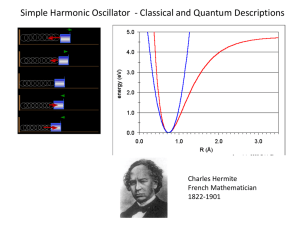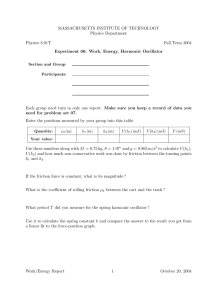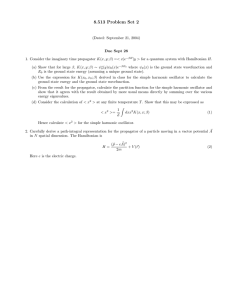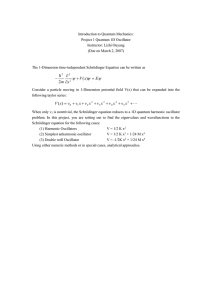Harmonic Oscillators-14
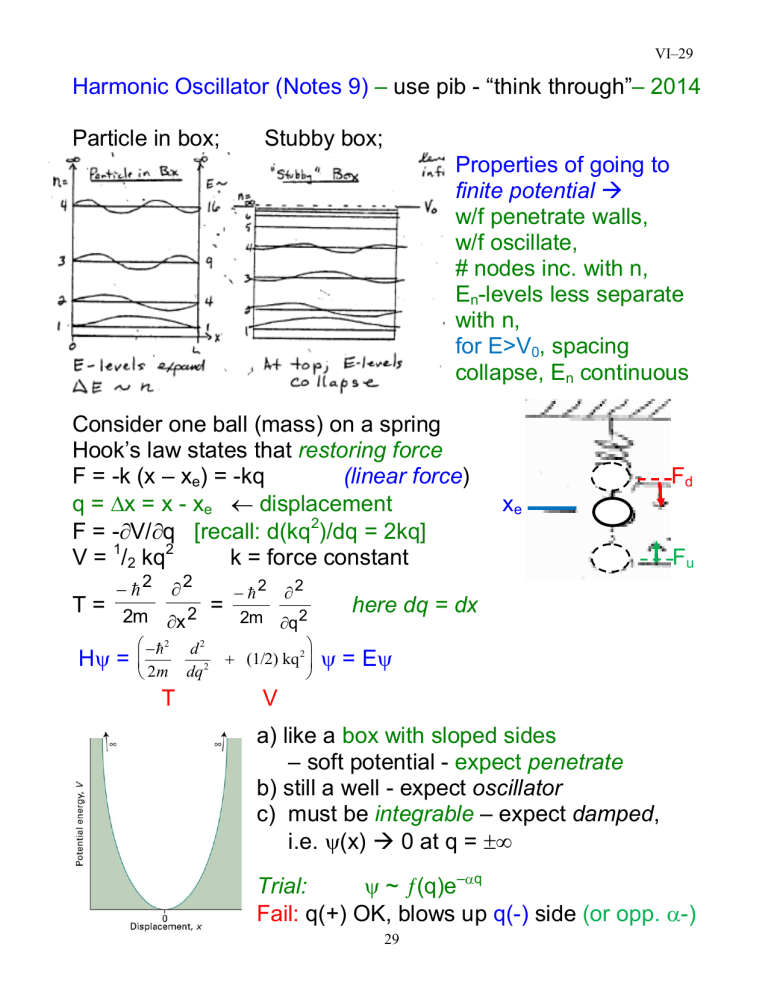
VI–29
Harmonic Oscillator (Notes 9) – use pib - “think through” – 2014
Particle in box; Stubby box;
Properties of going to finite potential w/f penetrate walls, w/f oscillate,
# nodes inc. with n,
E n
-levels less separate with n, for E>V
0
, spacing collapse, E n
continuous
Consider one ball (mass) on a spring
Hook’s law states that restoring force
F = -k (x
V =
1
/
2
– x e q =
x = x - x
) = -kq e
displacement x
F = -
V/
q [recall: d(kq
2
(linear force ) F
)/dq = 2kq] e d
kq
2
k = force constant F u
T =
H
2 m 2 x
2
2
=
2 m
2 d 2 dq 2
=
2 m 2 q
2
2
(1/2) kq 2 here dq = dx
= E
T V
a) like a box with sloped sides
– soft potential - expect penetrate b) still a well - expect oscillator c) must be integrable – expect damped ,
i.e.
(x) 0 at q =
Trial:
~
(q)e
– q
Fail: q(+) OK, blows up q(-) side (or opp.
-)
29
VI–30
Solution:
~
(q)e
– q2
works both side - (
must positive )
(q) – polynomial form works f
0
~c onst – orthog: f
1
~q (odd-even)
orthog.
if
2
(q) ~ q
2
-const
Result
–
(Atkins p.300-06
– confusing) – see House Ch. 6 not to derive, just get idea
Wave function (from Engel )
– modify variable to simplify:
(y) = H
(y) e
-y2/2
= 0, 1, 2, … (quantize) recursion formula :
H
(y) = (-1)
e y2
d
/dy
(e
-y2
) y =
q
=2
mk h = mk q non-classical: see wavefunction penetrate potential
[Engel - difference – classical: sin q & turning point at V(q m
)]
Hermite polynomials (H
: ex: H
0
= 1 note: – odd - even progression
H
H
H
H
H
H
4
5
6
1
= 2y
2
= 4y
2 – 2
3
= 8y
3
= 16y
= 32y
= 64y
– 12y
4
- 48y
2
+ 12
– alternate exponents
–
number solution,
– add exponential term,
2 exp[-y
6
5
-160y
3
+ 120y
- 480y
4
+ 720y
2 – 120
= 0,1,
/2], to get damping
…∞ thus:
= A
H
(y)e
-y2/2
y =
q A
=(2
!)
-1/2
(
)
1/4
30
VI–31
Homework: insert
into Schrödinger equation to get:
E
= (
+ ½)
= k m
= (
+ ½) h
=
/2
note: – even (constant) energy level spacing:
E = h
– zero point energy: ½ h
– heavier mass, ↓
E
0 classical
– weaker force constant, ↓
E
0
Shapes: wave fcts probabilities (House) (Atkins)
31
VI–32
Probabilities: low
– high in middle; high
– high at edge
This fits classical, turnaround points slower motion
A.
Solutions for
= 0-4
B.
(x)*
(x), probabilities for
= 0,4,8 compared to classical result (---)
Plots of
( probabilities ) for
= 0 – 4 and n = 12, from Engel
To describe two masses on a spring (relate to molecules) need to change variables q = (x
2
- x
1
) – (x
= r – r eq r = x
2
– x
1
0
2
- x
0
1
)
(3-D representation) relative 1-D position in this case:
= m
1 m
2
/(m
1
+ m
2
) reduced mass goes into
2-mass harmonic oscillator:
= [( 2
/2
d
2
/dq
2
+
1
/
2
kq
2
]
= E
and get E
= (
+
1
/
2
)
(
+
1
/
2
) h
= k
=
1
/
2
Use to model vibration of a diatomic molecule – low k
32
harmonic (ideal) spacing regular
VI–33
E-levels collapse in
real molec.
anharmonic anharmonic probability distribution , even
multiatom 3n - 6 relative coord – complex but separable
Two-dimensional Harmonic oscillator:
H = T + V
T = 2
/2m (
2
/
x
2
+
2
/
y
2
)
V = V(x, y) expand about x = 0,y = 0 (Taylor series)
= V(0, 0) +
V/
x
+ ½
f(x) =
2
V/
y
2
0
y n
1/n!]d
2
0
+ ½
n f/dx n
| x0
(x-x
0
)
x +
V/
y
0
y + ½
2
V/
x
y
n
(here expand for x
0
=0)
2
V/
x
0
xy +1/6
2
0
x
2
3
V/
x
3
0 x
3 …etc.
– more complex potential – expands to
∞ powers, dec. in size
– not separated -- cross-terms like
2
V/
x
y mix variables
– V(0, 0) = 0 – arbitrary constant – just shift E, can ignore
–
V/
x
0
=
V/
y
0
= 0 – evaluate derivative at min. choose x = 0, y = 0 as the minimum, so 1 st
term in q disappear
– same as choosing q = 0 as origin for q = x-x e
Then V = ½(
2
V/
x
2
)
0
x
2
+½ (
2
V/
y
2
)
0
y
2
+½ (
+ ½ k xy xy + …
2
V/
x
y)
0
xy
= ½ k x
x
2 where k x
= (
2
+ ½ k y y
2
V/
x
2
)
0 etc. – 2-D force constants, many
– same form as harmonic oscillator, if neglect terms, like x
3
33
VI–34 solvable if can separate variables
– do change of variable x, y
q
1
, q
2
where q
1
, q
2
chosen so that potential is not coupled, mixed coord.
– V(q
1
, q
2
) = ½ k
1
q
1
2
+ ½ k
2 q
2
2 q n
– normal coordinates
– call this potential “diagonalized” – use matrix approach can do to arbitrary accuracy
– also works for n-dimensions: (3n - 6) vibration
Basis for vibrational spectroscopy – IR and Raman
We will discuss further in spectroscopy section at end
34


